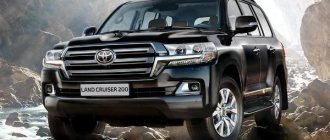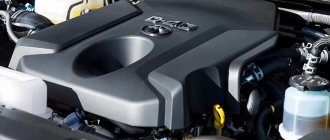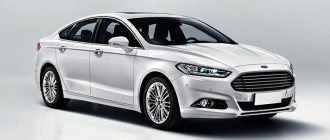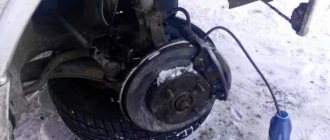Features of the diesel Corolla
Toyota Corolla 1.4 diesel has a displacement of 1398 cm3, but is characterized by high efficiency and sufficient agility. Its power is only 90 hp. With. at 6000 rpm. At the same time, the torque at 5200 rpm reaches 157 Nm.
The fuel consumption declared by the manufacturer for the diesel version is only 5 liters in city driving mode, and about 4.2 liters on the highway and in the combined cycle. This characteristic adds to the popularity of Toyota Corolla with diesel.
Another important feature that the description of any engine always includes is the level of exhaust toxicity. For the Corolla, all diesel units comply with the Euro-4 standard. At the same time, the engine itself is slightly heavier in weight than a gasoline engine and requires more frequent oil changes.
On diesel versions, as on gasoline ones, there is a semi-rigid suspension, which consists of a MacPherson strut at the front and a semi-independent beam at the rear. The Corolla diesel is equipped with a five-speed automatic transmission. The appearance of a Toyota Corolla with an engine of this type is not particularly different.
A special feature of diesel units is their susceptibility to cold temperatures: diesel fuel freezes at temperatures below -35°.
Numerous reviews from owners of this Corolla modification are positive and indicate the demand and popularity of the car. And if you add to this efficiency and optimal dynamism, the advantages are obvious.
Technical data
Toyota D4D is a four-stroke, diesel, 1.4 liter engine, the four cylinders of which are placed in one row. This engine has a different factory marking 1ND TV and has the following technical characteristics:
- serial production of Toyota D4D was carried out from 2002 to 2016;
- the cylinder block is made of aluminum, has an open cooling jacket, with wet cast iron liners;
- The cylinder head is made of aluminum alloy;
- SOHC type gas distribution mechanism, has one overhead camshaft and eight valves, 2 for each cylinder;
- the timing drive is carried out by a metal chain, hydraulic compensators are not provided here;
- diagram of the D4D fuel system, with Common Rail direct injection from Bosch;
- used high pressure fuel pump CP3S3;
- on internal combustion engines with a power of 70 hp, CT2 or CT9 turbines are used; on models with higher power, turbines with variable geometry GarretGT1444V or GT 1241 are used;
- The exact volume of the cylinders is 1364 cm3, cubic meters.
- compliance with European environmental requirements Euro 4, Euro 5;
- this engine has a piston stroke greater than the cylinder diameter of 81.5 and 73 mm, respectively. People call such internal combustion engines long-stroke. Their peculiarity is low load on the cylinder walls and piston group;
- The power of the power unit at 3000-4000 rpm ranges from 68 to 90 hp. And the torque at 2000-3000 rpm is 170 - 205 Nm.
- the compression ratio of the combustion chambers is from 16.5:1 to 17.9:1.
Reviews
Victor, driving experience – 15 years
I picked up my 2005 Toyota Corolla with a mileage of 60,000 km, this was in 2008. I've been driving for a long time, I have no complaints, the diesel engine works as it should. The first year I got used to the automatic after the manual, now I can’t imagine another transmission. Surprisingly, the motor is almost silent and pulls well at speed. Fuel consumption on the highway is only 5 liters per 100 km, and in the city - around 6 liters. After another 50 thousand km, I replaced the pump and changed the antifreeze. In general, no complaints - the best option for those who want to save money. By the way, all diesel variations before 2008 and after were assembled exclusively for the European market, which means the quality is appropriate.
Dmitry, driving experience - 16 years
I am the owner of a 2009 Corolla with a 1.4 liter diesel engine. The total mileage of my car, purchased from the first owner, is 180,000 km. I personally drove 35,000 km on it. In the process, I replaced the diode bridge of the generator, stabilizer bushings, added oil (I do this every 8–9 thousand km) and changed the filter. The technical resource for which the engine is designed, with a small volume, is sufficient for normal acceleration. And if you add maneuverability and adhesive suspension to this, then, in my opinion, you cannot yet find equal competitors for that amount.
Svetlana, driving experience – 10 years
2008 turned out to be a successful year for me, this was associated not only with the purchase of a diesel Corolla, but also with the successful experience of its operation. In most cases, the lineup was represented by gasoline units, but I wanted to switch from diesel to diesel. And I didn’t regret that I chose this model as a new car. Real savings and a beautiful stylish look are all a girl driver needs!
Sergey, driving experience – 21 years
My beauty 2008 was brought from Europe, since the Japanese concern did not offer diesel engines for Russia. I was pleased with the ability to start in cold weather, even at -40 degrees. Experienced drivers constantly warned me about the difficulties, but I didn’t notice that my fuel froze. It’s also cool that the power is 90 hp. s is a small tax.
Device design features
1ND TV is the first small diesel engine with an aluminum cylinder block. The cooling jacket is open, similar to wet sleeves. The aluminum cylinder head has eight valves, two valves for each cylinder. SOHC timing mechanism with single overhead camshaft. Hydraulic compensators are not provided here. The timing drive is made by chain transmission. On models produced before 2008, the timing drive was carried out, in addition to driving the camshaft, by driving the oil pump, which was located in the cylinder head. After 2008, the oil pump was moved to the cylinder block. There he received his own chain drive from the crankshaft.
Features of fuel equipment
The D4D fuel equipment circuit is represented by a thirty-two-bit battery-type processor with a common rail (Common Rail). After the 2008 modernization, the time-tested, reliable electromagnetic injectors were replaced with piezoelectric ones, but four years later the electromagnetic injectors were again returned to the engine design. The engine is equipped with turbocharging and environmental equipment: an exhaust gas recirculation system, as well as a particulate filter.
Features of turbocharged 1ND TV
This engine is equipped with two types of turbines. Lower power models use turbos controlled by a wastegate. They come in two types: CT2 and CT9. Their heated part is combined with a manifold for exhaust gases.
On the 90 hp version of the engine in question, variable geometry turbines Garret GT1444Vс or Garret GT1241 series were installed. The control is carried out by an electric servo drive, supplied by Denso.
Environmental equipment
The D4D fuel system itself is an environmental equipment. From the start of production, the 1ND TV diesel engine complied with Euro 3 according to European environmental safety requirements. After 2008, the engine received an exhaust gas recirculation system, as well as a particulate filter, which contributed to the compliance of the internal combustion engine with Euro 4, Euro 5, depending on the electronics settings.
Features of fuel injection pump
The engine in question is equipped with a very reliable, durable Bosch CP3S3 fuel pump. In most cases, throughout the entire life of the internal combustion engine, owners forget about the presence of this part on the engine. This is because no problems happen to him. It takes a lot of effort to make the injection pump fail. This is possible if you regularly use dirty and low-quality diesel fuel. This, sooner or later, will lead to the formation of an abrasive coating on the pumping sections and their failure. The plungers will also suffer. With a long service life and severe frosts, fuel leakage may occur on the pump covers. The malfunction can be eliminated by replacing the sealing gaskets.
E140, E150, tenth generation
Toyota Corolla 2008
The most popular car on the planet was destined to become the representative of the tenth generation. Forty million copies sold. The car has become wider and longer, more economical and comfortable. Body rigidity has increased. The basic version has 15-inch wheels.
In the USA they sell cars with 1.8 liter petrol engines. One is 2ZR-FE (132 hp) and 2ZR-FAE, which has a Valvematik system and has increased compression (140 hp). In America, there is a choice of gearboxes between a six-speed manual and a five-speed automatic.
The base engine in Europe is Dual-VVTi (1.33 liters of gasoline, 99 hp). The second is a motor of the same design (1.6 l, 122 hp). New in Europe is the CVTi-S (Multidrive) variator.
E90, sixth generation
Toyota Corolla body E90
The debut of the sixth generation took place in May 1987. Only modifications with front-wheel drive or all-wheel drive remain. The engines remained both carburetor and injection. The 4A-GE engine (1.6 l) was modernized in 1990, which made it possible to increase its power to 135 hp. With. In Europe, the 1C diesel (1.8 l) was popular, the power of which increased to 67 hp. With.
All Corollas have independent suspension, but the station wagon had a continuous rear axle. In 1989, a sedan was equipped with all-wheel drive for the US market. Everywhere the service of Japanese brands is at a good level.
2ZR-FE
In 2007, the Japanese introduced the new 2ZR-FE with a displacement of 1798 cc. see The engine replaced the 1ZZ, which was not particularly liked in automotive circles and was criticized. The power plant received an intermediate position between the “senior” 3ZR and the “junior” 1ZR. The cylinder diameter of this engine is 80.5 mm and the piston stroke is 88.3 mm. In the spirit of Japanese engine engineering, the 2ZR-FE features a four-row aluminum block and an aluminum 16-valve cylinder head. It is capable of developing 140 horsepower and 175 Nm of torque. The camshafts rotate due to the timing chain. The engine features ACIS and ETCS-i. The presence of hydraulic compensators frees the car owner from the need to adjust the valves.
The Dual VVT-i phase regulator is quite reliable and generally does not cause problems. The main complaints of car owners are in one way or another related to oil. The manufacturer allows lubricant consumption to a level of 1 liter per 1000 kilometers, but this suits few. There is only one solution - change the rings and caps. There are many complaints about the increased noise of the 2ZR-FE. First of all, you need to look at the chain, especially if it has never changed in 125-150 thousand kilometers. In rare cases, a water pump “lives” over 70 thousand km. Many car owners had to replace it even before completing 50 thousand km. The intake manifold and throttle body quickly become overgrown with carbon deposits, which requires periodic maintenance and attention from the driver. Average resource – 280 thousand km.
2ZZ-GE
Yamaha specialists developed a 1.8-liter 2ZZ-GE gasoline engine specifically for sports modifications. Compared to the 1ZZ, it received a composite cylinder block with a reduced crankshaft stroke and an increased cylinder diameter. The “feature” of the engine is considered to be an improved variable valve timing system, called VVTL-i. In fact, this is VVT-i from the 1ZZ-FE engine, but with the difference that after 6200 crankshaft revolutions per minute, the valves rise to 11.2 and the engine produces 192 horsepower at 7600 crankshaft revolutions per minute.
After driving 150 thousand km, all owners of cars with 2ZZ-GE under the hood will experience increased oil consumption. A smooth but steady increase in oil consumption indicates an impending major overhaul. You can delay global costs by performing decoking, but after a while you will still have to either refurbish the old motor or look for a contract one. Also quite noisy operation, floating speed - all this has not gone away and periodically causes problems for the driver. You need to look and clean the throttle assembly. It is extremely important to monitor and maintain the variable valve timing system. If it starts to malfunction, there will be a significant reduction in power. The engine life of the Toyota Corolla 2ZZ-GE is approximately the same as that of the 3ZZ-FE - 200 thousand kilometers.
E120, E130, ninth generation
Toyota Corolla 2001
The ninth generation started in 2001 in Frankfurt. The new brand was specially developed for Europe. There are quite a few body styles: a high-capacity station wagon, a sedan, three- and five-door hatchbacks, and just a station wagon. There was a new product with a 1.8 liter engine producing 192 hp. With. and manual gearbox-6 (Toyota T-Sport). The diesel engine received a power supply system.
In 2004, moldings, optics, bumpers were updated, and airbags appeared on the side. This generation is still in demand on the used car market.
1NR-FE
Since 2008, a 1.3-liter power unit labeled 1NR-FE has been assembled in Japan. There are two known modifications that differ in environmental class - Euro-3 and Euro-4/5. Its block is made of aluminum, cast iron liners, cylinders with a diameter of 72.5 mm. An open cooling system is responsible for proper temperature conditions. A 16-valve cylinder head, also made of aluminum, is fixed on top of the block. The motor is difficult to overhaul, so in the event of a critical breakdown, they usually look for a contract copy. The gas distribution mechanisms located under the cylinder head are driven by a chain. She is reliable and there is basically no question about her resource. The chain is single-row and equipped with a hydraulic tensioner.
Feature of 1NR-FE – Dual VVT-i. The timing drive is located under a cast cover, there is also a water pump and an oil pump. The engine is quite common and was supplied to Russia along with the ninth generation Toyota Corolla. This power unit was also installed on Auris and Yaris. Another technological innovation that distinguishes the 1NR-FE is the ECTS-i system. It is designed to intelligently control the electromechanical throttle valve using impulses received from the accelerator position sensor.
Among the most well-known malfunctions of 1NR-FE it is worth noting:
- Increased oil consumption. Again, a problem that appears at medium and high mileage. The problem is that once the connecting rods, pistons and pins are separated, they cannot be put back together. If the rings are stuck, repairs will be expensive. Pistons cannot be replaced separately from connecting rods.
- Nagar. Usually forms on the walls of the combustion chambers and on the valves. Due to tar deposits, the compression level drops. There are difficulties starting the engine, complications caused by unstable idle speed. Another reason is the EGR valve. It also promotes the rapid formation of soot.
- Ignition coils. This engine does not last long, however, neither does the cooling system pump.
- Noisy operation. Many motorists attribute the rather high level of noise in the operation of 1NR-FE to the features of the VVT-i system. This drawback is practically impossible to eliminate.
If you hear metallic clanging when “cold,” then it’s worth checking the timing chain and tensioner. If the noise is too high, the timing drive mechanism must be replaced along with the hydraulic tensioner.
Very often, owners complain about errors P2111 and P2112 regularly appearing. As in many other cases, it all starts with activating the "Check Engine" indicator on the instrument panel. This problem can be eliminated by changing the throttle assembly and reflashing the “brains”. Taking into account all of the above, the 1NR-FE motor can hardly be called reliable. Its resource largely depends on the quality of service and the nature of operation. However, obvious “illnesses” and shortcomings will appear even with the most reverent attitude - it’s a matter of time. If we average the resource, we get a figure of 200 thousand km.
Operational maintenance of 1ND TV
Proper maintenance of the power unit can extend its service life, and incorrect maintenance can significantly reduce it. Therefore, it is very important to carry out the following technical measures in a timely manner:
- The most common and important procedure when servicing an engine is replacing the engine lubricant. It must be performed every 10,000 kilometers. The oil volume in the engine is 4.8 liters; when replacing, you need to take 4.3 liters. Types of oil used by viscosity: 5w30 and 0w30. When changing the oil, you need to install a new oil filter;
- The timing chain drive, according to the manufacturer, has an unlimited resource. In reality, problems with the timing chain can begin after a mileage of 200 thousand km. Therefore, after this mileage has expired, the timing chain must be replaced with a new one;
- Valve adjustment must be performed after 100 thousand km. mileage. The adjustment procedure is very simple, using screws and locknuts;
- the attachment belt must be replaced after 100,000 kilometers;
- antifreeze, spark plugs and a filter in the fuel tank must be replaced after 80 thousand km;
- The fuel and air filters need to be changed after 20 and 10 thousand km, respectively.
Even a novice driver can perform these simple procedures. This will ensure long-term operation of a reliable power unit.
Toyota Corolla with diesel and gasoline: are there any other differences?
Externally, the car is completely identical to the petrol version, with dimensions of 4540 mm in length, 1760 mm in width and 1470 mm in height. The wheelbase is quite wide – 2600 mm. This enabled the creators to create a fairly spacious interior. Car clearance – 150 mm. Toyota Corolla smoothly and gently goes over bumps, but is not designed to overcome off-road conditions and broken roads. The new generation of Toyota Corolla has a reduced turning radius of 10.4 m. This allows you to park and turn around without accidents. For the same purpose, the image from the rear parking camera is displayed on the inside mirror, and the mirror itself is automatically darkened and does not reflect into the driver’s eyes.
Despite its compactness, the car is very roomy. The trunk volume is 450 liters, which is quite impressive compared to classmates (for comparison, the trunk volume of the Lancer X is 315 liters).
Elegance and restraint in the exterior of Toyota Corolla
Ease of control is provided by electric power steering. The car has good grip, but the Corolla lacks agility when cornering and quick response to steering turns. For comfortable driving, the steering rack is adjustable in height and depth.
As for the interior trim, it is the same for all versions of the Corolla of the same generation, regardless of fuel type. The interior of the new generation car is designed for driver comfort. The steering wheel is slightly flattened at the bottom, has leather upholstery and high-quality stitching. Sealing in the palm area relieves stress on the hand joints and makes it easier to control and grip the steering wheel. The armrest is moved forward, closer to the gearshift knob for added driver comfort.
Ergonomic interior of the Corolla
The model provides a choice between fabric and leather upholstery. Comfort is also provided by additional options, such as:
- heated seats;
- electric windows;
- heated mirrors;
- multifunction steering wheel for controlling the audio system;
- air conditioner;
- climate control;
- Rain sensor;
- possibility of folding side mirrors;
- audio system;
- central locking;
- immobilizer, etc.
The dashboard has only two analogue devices: speedometer and tachometer. Basic information is also displayed on the on-board computer.











